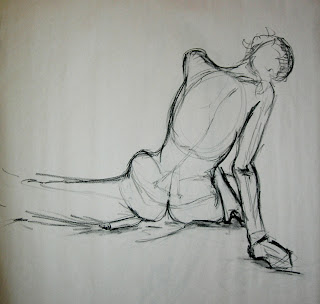

I decided to post two pictures that show how I am always learning. In the picture of just the torso, my first one was too straight and did not show an accurate depiction of the models position. After Amy pointed out my flaw I was able to go back and readjust. For the second drawing we were focusing on learning to foreshorten. This by the way is a tricky thing to learn because your eyes and brain are always in conflict. In the second drawing I had drawn the model on too much of a slope. Once again, Amy was able to show me where the model actually fell on the picture plane and I was able to correct what I had drawn (the correct drawing is in brown).
Always in class, and especially during these drawings I am thinking about one day being the teacher assisting the students. Its a little unnerving to think about because of the what I think were obvious mistakes I failed to see in my two drawings. But then again, I do need to remember I am still in the very beginning of this life drawing learning process and learning takes time. So if I take a step back and commit to memory these feelings and thoughts of being at the beginning of learning something new, that could really help me be a better teacher. I will be able to communicate and instruct more effectively to my students because I will know what they are thinking and feeling. I will be able to genuinely remind them that they are in a learning process and it doesn't happen instantly. One thing that always comforts me in drawing class is when Amy reminds us that this isn't easy and the skill won't come right away. It takes the pressure off during class because you aren't thinking about being the best, but doing your best.


















